This easy Thai Drunken Noodles Recipe (Pad Kee Mao) is a spicy stir fry noodles dish with savory and umami flavors. The wide rice noodles are seasoned with the perfect amount of sauce made from fish sauce, soy sauce, and oyster sauce and then finished with a generous amount of fresh Thai holy basil. It comes together quickly, ready in less than 40 minutes!

Jump to:
Why this recipe works
- This Pad Kee Mao recipe doesn't have to be spicy! Like many Thai cuisine dishes, you can adapt the spice level to your taste preference.
- You can use any protein of choice for the recipe. Chichen, beef, pork, shrimp, and squid work well in the recipe
- Make it vegetarian by using tofu and tempeh, and add extra vegetables.
- You can make the sauce ahead of time. Make it in the morning, and keep it in the fridge until lunch or dinner for cooking. It helps keep your cooking time even quicker.
What are Drunken noodles?
Drunken noodles or Pad Kee Mao (ผัดขี้เมา) is one of Thailand's most popular rice noodle dishes. The savory and chewy rice noodles are delightful and easy to make, perfect for a quick lunch or dinner.
Traditionally, Thai holy basil, a specific type of basil, is used for this stir fry. But they are difficult to come by in the United States, so Thai sweet basil is often used. Most especially in Thai restaurants.
The origin of the dish's name is still being debated. The Thai language translation of Pad Kee Mao is "Stir-fry drunkard". Not knowing exactly how the "drunkard" part plays a role in naming the dish.
Perhaps the drunkards needed a lot of chilies added to the sweet and salty flavors of the stir fries to help sober them up after a long night of drinking. Or maybe the stir fry was so spicy that it makes one's head spin, like when you've had too much to drink. No one and everyone are sure they know the true story behind the name. (;
No matter the true tale of this Thai dish, the good news is that we don't need to make the dish so spicy that it sounds scary to taste. That's the beauty of home cook meals! We can adapt the spice level to our taste buds.
A Note on the Holy basil
If you can, use holy basil for the best flavor combination. The spicier taste of the holy basil makes this dish stand out from many noodle stir-fry dishes. Thai holy basil, also called Tulsi, has a fragrant peppery, licorice, and cinnamon-like taste.

If Thai basil is unavailable, Italian basil will work but double up on the portion of the regular basil. Globe basil or cinnamon basil works well as a stand-in for substitutes.
During the summer, I've seen these different basil varieties at nurseries or home improvement stores like Lowe's and Home Depots. I firmly believe that it is better to have some basil used than to have none at all.
Read this helpful guide about the different types of Thai noodles used in Thai food. Look for the long wide noodles for the best noodles used for Drunken noodles. Fresh noodles are best and quicker to cook, but dried noodles work just as well with a little preparation.
Ingredients for making Pad Kee Mao
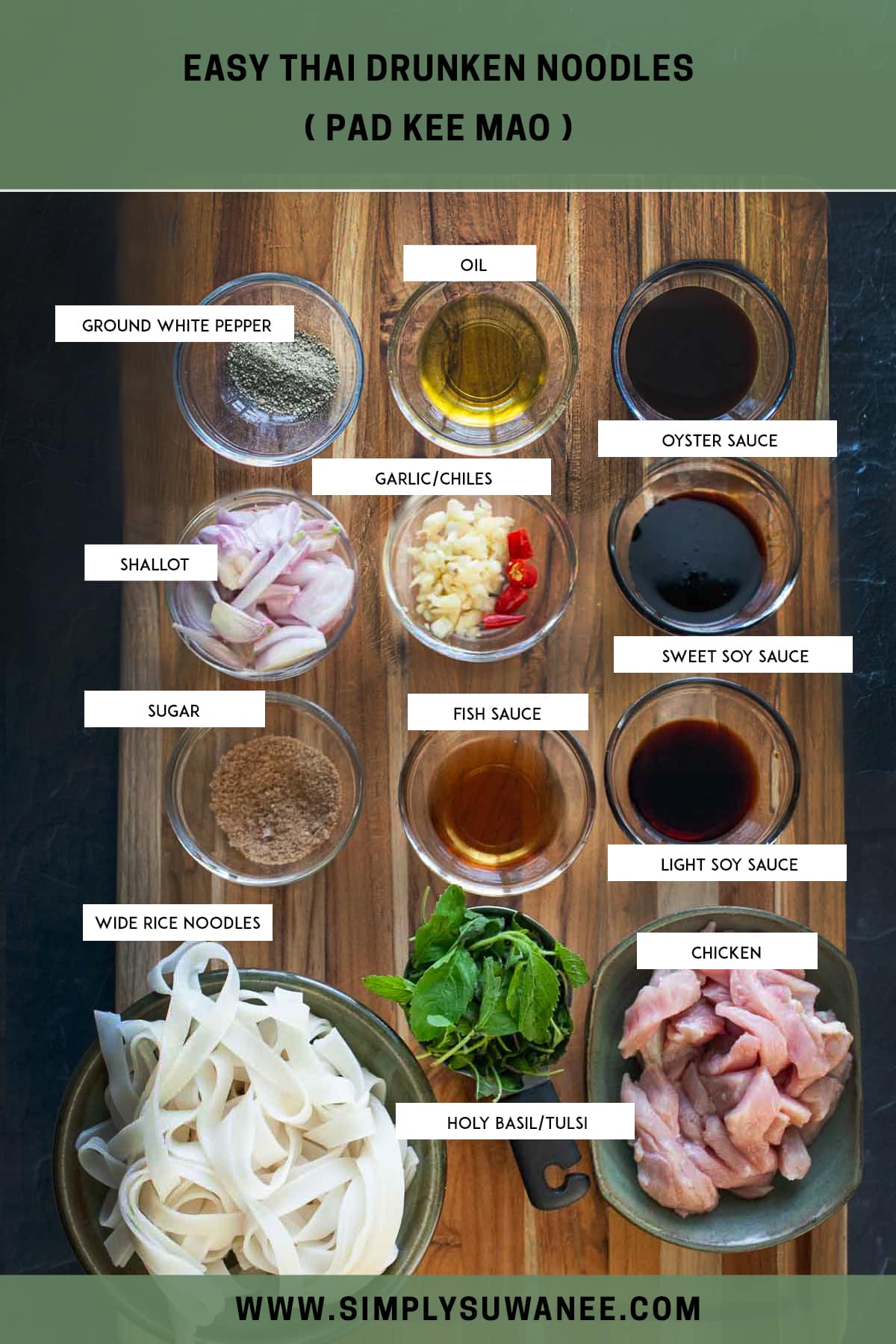
Pad Kee Mao sauce
Make the most irresistible Thai basil sauce using these authentic ingredients at your local Asian grocery store. Check the recipe card below for the exact measurements.
- Fish sauce. Use the Thai squid brand for this recipe. The wide noodles absorb more liquid, and the stronger fish sauce holds its flavor better. Find them at your local Asian market.
- Light soy sauce. Use a Thai brand if possible, but substitute with any you have. Adjust by adding more at the end of the stir fry as needed.
- Sweet dark soy sauce. It's sweet soy sauce that has a smoky molasses-like flavor. This savory sauce adds a caramel brown color to the noodles.
- Oyster sauce. The oyster sauce adds an extra umami flavor to the stir fry. Use vegetarian oyster sauce for a meatless sauce.
- Sugar. Palm sugar is the authentic sweetener but white or brown sugar works.
The main ingredients
- Vegetable oil. Use neutral oil like vegetable, canola, or avocado oil.
- Protein. This recipe uses chicken, but you can choose your favorite choice of protein to go with this recipe.
- Rice noodles or rice sticks. Fresh wide rice noodles are best for this recipe. If not, find the largest flat rice noodles at your local Asian grocery stores. (The dry rice noodles must be cooked in boiling water before cooking. Soaking the noodles in hot tap water works, but it will take a while to soften up or get to the al dente texture.
- Thai Holy basil. They can be hard to find. Use Thai basil with purple stems. In a pinch, use Italian basil but double up on the portion.
- Fresh Thai chilies. This Thai noodle dish is known for its fiery spiciness! The heat level can be adjusted here using red bell pepper instead.
- Garlic. Use a generous amount for this recipe.
- Shallots. You can substitute red, sweet, or white onion.
How to make the best Thai drunken noodles
Step 1. Make the drunken noodle sauce in a small bowl by mixing the sauces, ground white pepper, and sugar. Set aside.

Step 2. Prepare the dried noodles according to the package instructions. If using fresh rice noodles, still follow w the package directions for the best results and consistency of the noodles.

Step 3. Heat a wok or large skillet at medium-high heat. Allow the pan to warm up, then add oil. Wait a few seconds, then swirl the oil to cover the wok's surface as much as possible. Add garlic and chili peppers, stir, and cook for 10-15 seconds or until lightly browned.

Step 4. Add the chicken and cook for 4-5 minutes or until the meat is lightly browned in parts. Stirring often.
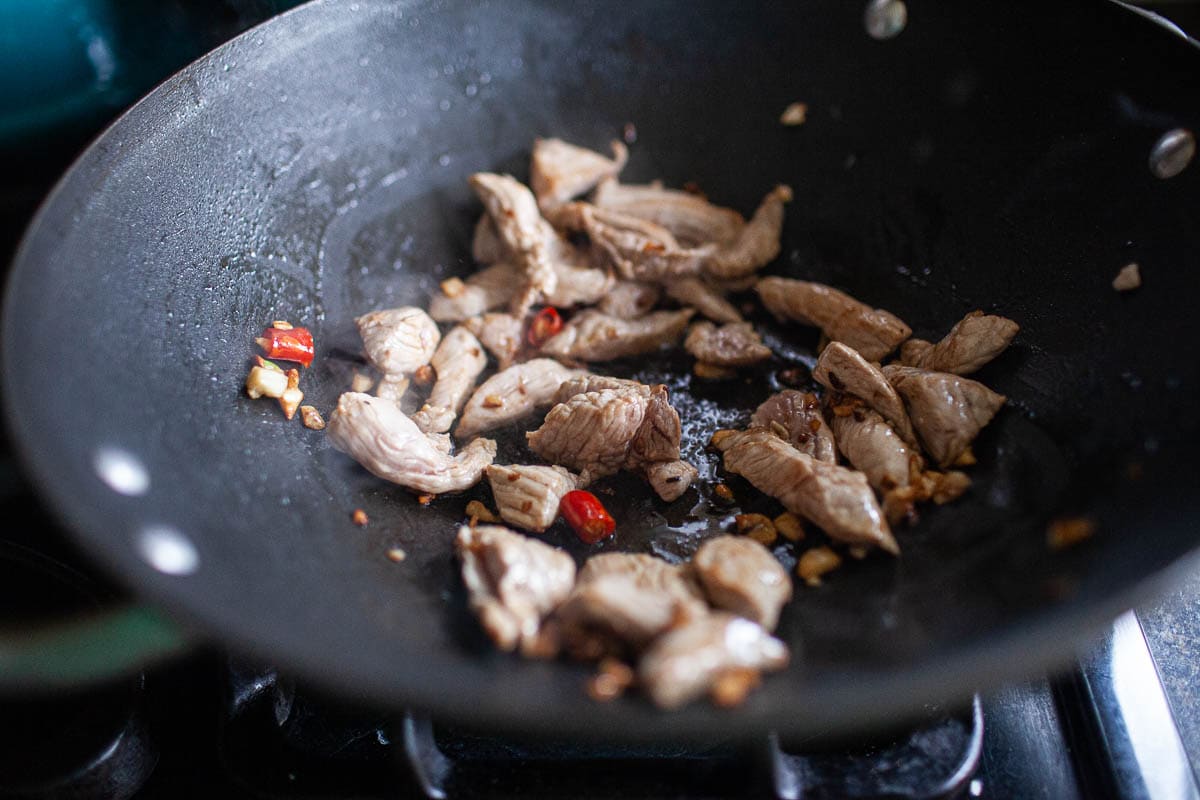
Step 5. Add the shallots and cook for 1-2 minutes until the shallots are lightly softened.

Step 6. Add the noodles and the sauce, stir well, and cook for 2 minutes. Taste the stir fry and adjust with a dash more sugar, fish sauce, or soy sauce until you get the right balance. The noodles should be chewy and soft. If not, allow it to cook for 1-2 more minutes.

Step 7. Add the holy basil here and cook for 1 more min. Turn off the heat and serve hot.
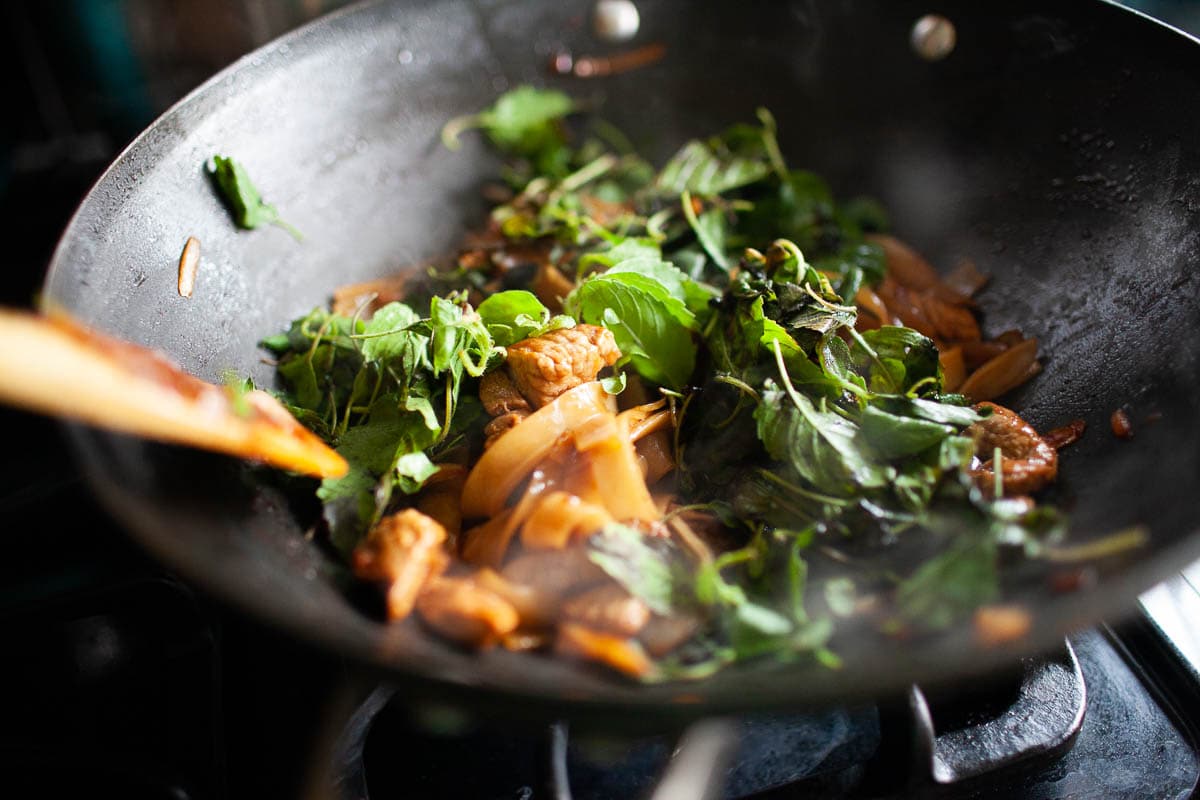
Garnish each plate with a lime wedge, thinly sliced fresh basil, ground chili flakes, and slices of cucumbers to help cool off the heat.
Helpful Kitchen Notes
- This recipe can double up very easily for a larger family or crowd. It also serves well as leftovers for the next day or two.
- For added fresh veggies, use snow peas, Chinese broccoli, baby corn, green onion, sweet bell peppers, and broccolini florets.
- To tame the infamous heat of this spicy noodles dish, use less or omit the Thai chile. Adjust the heat accordingly.
- Add extra ground white pepper, red chili flakes, and red chili sauce like Sriracha or garlic oil for spicy food lovers.
- Add the holy basil last, right after you turn off the heat, as the basil will wilt very quickly, and you don't want to overcook it.
FAQs
What makes drunken noodles drunken?
The name "drunken" comes from several speculations in the Thai tale that the spicy dish helps cure the drunkard's hangover. Or the dish is so spicy with many hot chiles used that it makes one's mouth burn and head spin, similar to having too much alcohol.
What is the difference between Pad Thai and drunken noodles?
Pad Thai and drunken noodles are different recipes using different sizes of noodles, sauces, and spiciness levels. Pad Thai is typically gluten-free, with no soy sauce in the seasoning. Drunken noodle recipes use different soy sauces, and the noodles are typically larger. A big difference is that Drunken noodles have basil, whereas Pad thai does not.
Are Thai drunken noodles spicy?
Traditionally, drunken noodles are spicy, with lots of fresh hot Thai peppers used to cook the noodles. However, you can adjust the number of hot peppers to adapt to your spiciness.
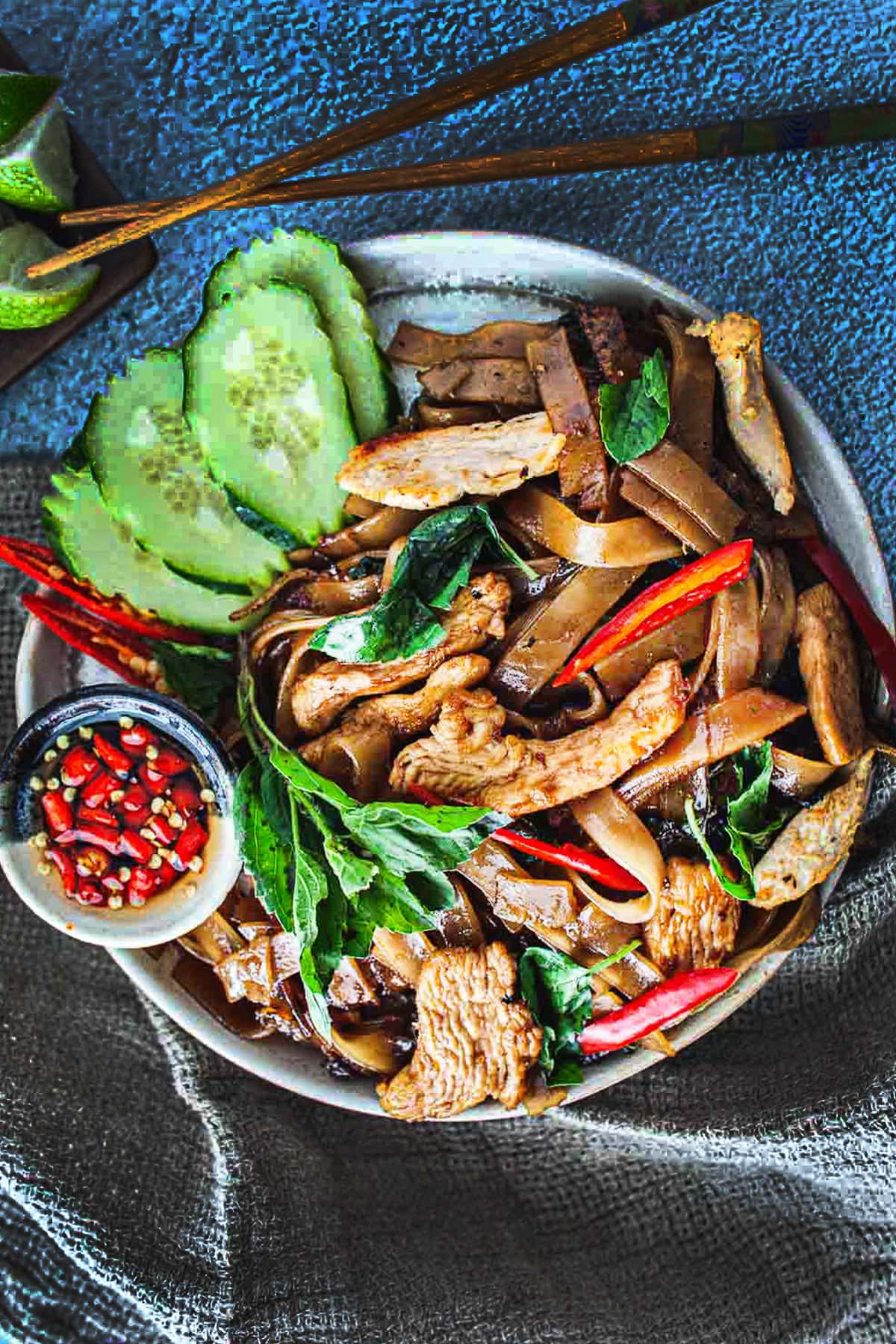
More Thai dishes You'll Love
- A guide to different types of Thai noodles
- Pad See Ew recipe
- Easy and authentic Pad Thai noodles with shrimp
- Easy beef Pad Thai without tamarind
- Pad Mee Korat, a spicy Thai noodles dish
- Pad mee, a simple vermicelli rice noodles recipe
- Pad Woonsen noodles stir fry recipe
- Glass noodle salad with shrimp
** Thank you so much for visiting my blog! This is truly a passion for me. If you have enjoyed these recipes and appreciate the hard work I put into them, I would love it if you would share them with your friends! Your recommendation is the highest review I could hope for, and I’d appreciate it! **
Enjoy Cooking!
Print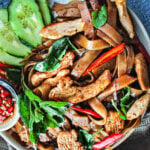
Easy Thai Drunken Noodles Recipe (Pad Kee Mao)
- Total Time: 35 minutes
- Yield: 4
- Diet: Low Lactose
Description
This easy Thai Drunken Noodles Recipe (Pad Kee Mao) is a spicy stir fry noodles dish with savory and umami flavors. The wide rice noodles are seasoned with the perfect amount of sauce made from fish sauce, soy sauce, and oyster sauce and then finished with a generous amount of fresh Thai holy basil. It comes together in less than 40 minutes!
Ingredients
The sauce
- 2 tablespoons fish sauce
- 2 tablespoon soy sauce
- 2 tablespoons sweet dark soy sauce
- 1 tablespoon oyster sauce
- 1 tablespoon sugar, palm brown or white sugar
- 1 teaspoon ground white pepper. Add more if you want the heat.
The main ingredients
- 2 tablespoon garlic
- 1-10 fresh chilies, chopped into small pieces. Adjust the spiciness level by using fewer chilis.
- 2 tablespoon oil. Use neutral oil like avocado, vegetable, or canola.
- 3 ounces shallot, sliced long and thin
- 8 ounces chicken, thinly sliced into 1 ½ inch pieces.
- 5 ounces dried wide rice noodles or 10 ounces softened noodles. Cook to package directions.
- ½ cup packed holy basil. Substitute Thai basil.
Instructions
- Make the drunken noodle sauce in a small bowl by mixing the sauces, ground white pepper, and sugar. Set aside.
- Prepare the dried noodles according to the package instructions. If using fresh rice noodles, still follow w the package directions for the best results and consistency of the noodles.
- Heat a wok or large skillet at medium-high heat. Allow the pan to warm up, then add oil. Wait a few seconds, then swirl the oil to cover the wok's surface as much as possible. Add garlic and chili peppers, stir and cook for 10-15 seconds or until lightly browned.
- Add the chicken and cook for 4-5 minutes or until the meat is lightly browned in parts. Stirring often.
- Add the shallots and cook for 1-2 minutes until the shallots are lightly softened.
- Add the noodles and the sauce, stir well and cook for 2 minutes. Taste the stir fry and adjust with a dash more sugar, fish sauce, or soy sauce until you get the right balance. The noodles should be chewy and soft. If not, allow it to cook for 1-2 more minutes.
- Add the holy basil here and cook for 1 more min. Turn off the heat and serve hot.
Garnish each plate with a lime wedge, thinly sliced fresh basil, ground chili flakes, and slices of cucumbers to help cool off the heat.
Notes
- This recipe can double up very easily for a larger family or crowd. It also serves well as leftovers for the next day or two.
- For added fresh veggies, use snow peas, Chinese broccoli, baby corn, green onion, sweet bell peppers, and broccolini florets.
- To tame the infamous heat of this spicy noodles dish, use less or omit the Thai chile. Adjust the heat accordingly.
- Add extra ground white pepper, red chili flakes, and red chili sauce like Sriracha or garlic oil for spicy food lovers.
- Add the holy basil last, right after you turn off the heat, as the basil will wilt very quickly, and you don't want to overcook it.
** Thank you so much for visiting my blog! This is truly a passion for me. If you have enjoyed these recipes and appreciate the hard work I put into them, I would love it if you would share them with your friends! Your recommendation is the highest review I could hope for, and I’d appreciate it! **
- Prep Time: 20
- Cook Time: 15
- Category: Noodles, stir fries, chicken recipes
- Method: Stir-fried
- Cuisine: Thai





Ifong Chen says
making it tomorrow and what a helpful recipe here! Beautiful pictures.
Suwanee says
Authentic and delicous!
Amy says
This is a family favorite at our house. Once you have all the ingredients, it’s super simple to throw together and never disappoints!
Adriana says
Love this recipe!
When do you add the shallots?
I added first then did garlic and green chilies.
But recalling something about a shallot oil but don’t see now in this recipe.
Cassie Troja says
I forgot to mention that we were able to make this GLUTEN-FREE! We used coco aminos in place of the dark soy sauce, and gluten-free soy sauce for the normal soy sauce. The rice noodles were already gluten-free, so this dish is easily adaptable for celiac/gluten-intolerant folks! It’s delicious.
Cassie Troja says
This is my absolute favorite recipe from Simply Suwanee, which is saying something because we use several of her recipes on a regular basis (that cashew chicken and the red curry...?). If you like Thai food at all, you’ve *got* to try this one. It’s mouthwateringly delicious!
Suwanee says
Thank you Angela for coming by and such compliment! (O: I'd love to hear how these recipes turn out for you! xo
Angela D. says
Suwanee, your blog is gorgeous! And I have eaten your cooking so I cannot wait to try your recipes. This is our favorite dish and how Rob and I always rate a Thai restaurant, so we will definitely try this one. Thank you for sharing your talents!
Leslie says
This recipe is so delicious and easy to follow. Thanks Suwanee!
Suwanee says
Thanks Cassie. I honestly have never used coco aminos but here’s my suggestion. Mix honey in w the gf soy sauce for the sweetness and thickness texture like the sweet soy sauce. Molasses is also another option mixed in w gf soy sauce. Sweet dark soy sauce is made from molasses, so this option will be close! I may have to experiment too now! ?
Cassie T. says
I cannot wait to try this recipe! I have 2 questions for you though as I may have to make some adaptations due to food allergies:
1) do you think I could use coco aminos instead of the sweet dark soy sauce? I can easily find gluten-free soy sauce, but not so much the sweet dark soy sauce. I’m wondering if coco aminos would be an acceptable substitute given that it’s sweet?
2) Gluten-free soy sauce often tastes saltier. Would you recommend cutting the amount of salt, adding a little extra sugar, or leaving as-is?
I completely understand that you may not know the answers, so I may just have to experiment. I adore Thai food though, so I’m willing to take the risk!! Can’t wait to hear more. Your website and photography are gorgeous. ❤️